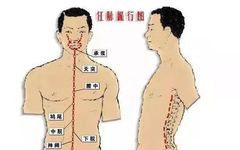The diagram of the Eight Extraordinary Meridians in the human body includes the Ren Mai (Ren Meridian), Du Mai (Governing Meridian), Chong Mai (Penetrating Meridian), Dai Mai (Belt Meridian), Yin Qiao Mai (Yin Heel Meridian), Yang Qiao Mai (Yang Heel Meridian), Yin Wei Mai (Yin Linking Meridian), and Yang Wei Mai (Yang Linking Meridian). The term “extraordinary” (qi) refers to their distinct nature. Unlike the twelve regular meridians, they are not directly associated with the organs and do not have interior-exterior pairings. Their physiological functions mainly involve the overflow and regulation of Qi and blood circulation in the twelve meridians.
1. Du Mai Pathway Diagram
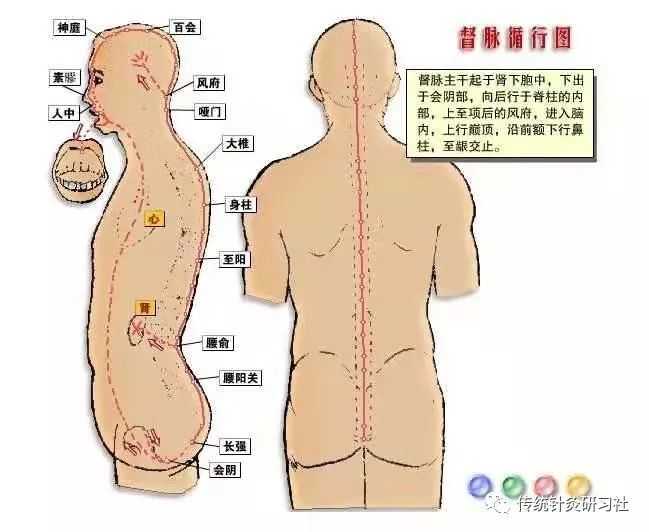
Du Mai Acupoint Song
The Du Mai runs along the spine, with twenty-eight acupoints starting from Changqiang (Long Strong). Yaoyangguan (Lumbar Yang Gate) enters Mingmen (Life Gate), Xuanshu (Suspended Pivot) is at the center of the spine, and the tendons contract to Yanggui (Spirit Platform). Shendao (Spirit Path) opens the body pillar, Dazhui (Great Vertebra) connects to Fengfu (Wind Palace), Naohud (Brain Door) is at the back of the head, Baihui (Hundred Meetings) is at the top, and Shuxing (Spirit Court) is opposite to Suli (Su Liao) at the lips, while Yinjiao (Gum Junction) is within the upper teeth.
The pathway and physiological functions of the Du Mai:
1. Pathway: The Du Mai originates from the lower abdomen, exits at the perineum, and travels to the Changqiang acupoint at the tailbone, ascending along the spine, passing through the neck to Fengfu, entering the brain, belonging to the brain, and following the midline of the head to Baihui, descending through the forehead to the tip of the nose at Suli, passing through the philtrum to Yinjiao.
2. Branches: The first branch originates with the Chong and Ren meridians from the lower abdomen, exits at the perineum, and meets with the Kidney Meridian (Foot Shaoyin) and Bladder Meridian (Foot Taiyang) at the tailbone, penetrating the spine and belonging to the kidneys. The second branch ascends directly from the lower abdomen through the navel, reaching the throat where it meets the Chong and Ren meridians, encircling the lips and reaching the center below the eyes. The third branch originates from the inner canthus of the eyes, ascends to the forehead, converges at the top of the head, connects to the brain, and then descends along the back of the neck, along the sides of the spine, reaching the waist and entering the muscles on both sides of the spine, connecting with the kidneys.
3. Physiological functions:
(1) Regulates the Qi and blood of the Yang meridians, known as the “sea of Yang meridians”: The Du Mai runs along the back, which is Yang, indicating its role in commanding and supervising the Qi of all Yang meridians. Additionally, the six Yang meridians converge at Dazhui, thus the Du Mai has a regulatory effect on the Yang meridians, hence the saying “it supervises all Yang meridians in the body.”
(2) Reflects the functions of the brain, kidneys, and spinal cord: The Du Mai belongs to the brain and connects to the kidneys. The kidneys produce marrow, and the brain is the sea of marrow. The relationship between the Du Mai, brain, kidneys, and spinal cord is very close.
(3) Governs reproductive functions: The Du Mai connects with the kidneys, and since the kidneys govern reproduction, the Du Mai is related to reproductive functions.
Ren Mai Acupoint Song
The Ren Mai runs through twenty-four acupoints, hidden between the two Yin at the perineum, with the Zhongji (Central Pole) before the pubic bone, Guanyuan (Gate of Origin) at the Qi Sea, Yinjiao at the Shenque (Spirit Gate) at the water point, Xiawan (Lower Abdomen) at the center, and Shangwan (Upper Abdomen) at the center, connecting to the Juewei (Coccyx) at the middle court, Zigong (Purple Palace) at the Xuanji (Rotating Mechanism), and Tiantu (Heavenly Pivot) at the end of the Lianquan (Lian Spring).
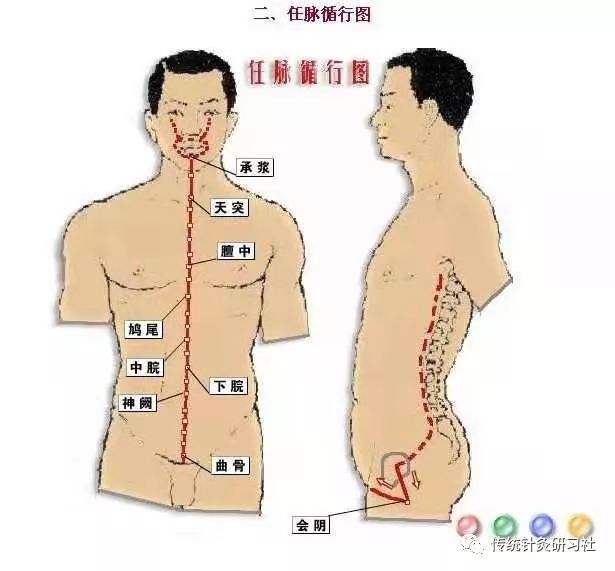
The pathway and physiological functions of the Ren Mai:
1. Pathway: The Ren Mai originates from the lower abdomen, exits at the perineum, travels through the Yin mound, ascends along the midline of the abdomen, passes through the throat (Tiantu), and reaches the inner lower lip, dividing left and right, encircling the lips, meeting at the Yinjiao acupoint, and then separately passing through the sides of the nose, ascending to the lower eye socket (Chengqi), converging with the Foot Yangming Meridian.
2. Branches: It penetrates the spine from the lower abdomen, ascending along the back.
3. Physiological functions:
(1) Regulates the Qi and blood of the Yin meridians, known as the “sea of Yin meridians”: The Ren Mai runs along the midline of the abdomen, which is Yin, indicating its role in overseeing and managing the Qi of all Yin meridians. Additionally, the three Yin meridians of the foot intersect with the Ren Mai, and the three Yin meridians of the hand connect with the Ren Mai through the three Yin meridians of the foot, thus the Ren Mai regulates the Qi and blood of the Yin meridians, hence the saying “it oversees all Yin meridians.”
(2) Regulates menstruation and nourishes the fetus: The Ren Mai originates from the lower abdomen, playing a role in regulating menstruation and promoting female reproductive functions, hence the saying “the Ren governs the uterus and fetus.”
3. Chong Mai Pathway Diagram

The pathway and physiological functions of the Chong Mai:
1. Pathway: It originates from the uterus, exits at the perineum, and divides into two branches. The ascending branch (the main part of the Chong Mai) runs along the anterior abdominal wall, near the navel (five fen beside the navel), ascends, parallels the Foot Shaoyin Meridian, spreads in the chest, and continues upward through the throat, encircling the lips; the descending branch runs along the posterior abdominal wall, ascending within the spine. The descending branch exits the perineum and descends along the inner thigh to the big toe.
2. Physiological functions:
(1) Regulates the Qi and blood of the twelve meridians: The Chong Mai ascends to the head and descends to the feet, traversing the entire body, serving as a crucial point for leading the Qi and blood of all meridians. When the Qi and blood of the meridians and organs are abundant, the Chong Mai can store and reserve them; when they are deficient, the Chong Mai can supply and replenish them to maintain the normal physiological activities of the body’s tissues and organs. Hence, it is known as the “sea of the twelve meridians,” “sea of the five organs and six bowels,” and “sea of blood.”
(2) Governs reproductive functions: The Chong Mai originates from the uterus, also known as the “blood chamber” or “blood sea.” The Chong Mai has a role in regulating menstruation. It is closely related to reproductive functions; for women, “when the Chong Mai is abundant, menstruation occurs regularly, leading to offspring.” For men, either congenital deficiency of the Chong Mai or acquired injury can lead to reproductive dysfunction.
(3) Regulates the ascending and descending of Qi: The Chong Mai, during its pathway, connects with the Foot Shaoyin, belongs to Yangming, and communicates with Jueyin and Taiyang. The Chong Mai has the function of regulating the ascending and descending of Qi in certain organs (mainly the liver, kidneys, and stomach).
4. Dai Mai Pathway Diagram
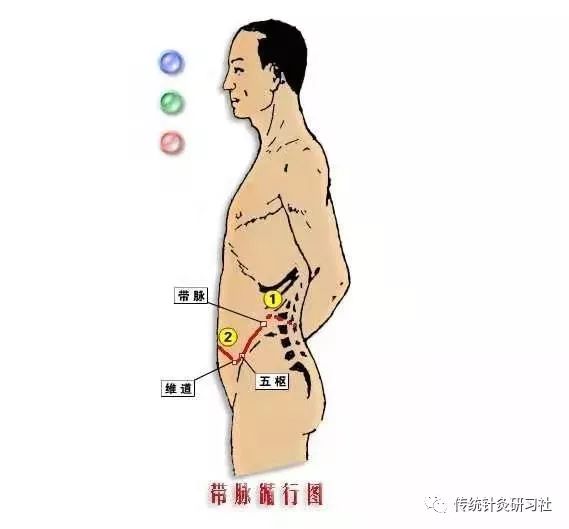
The pathway and physiological functions of the Dai Mai:
1. Pathway: The Dai Mai originates from the lateral costal region, descending obliquely, meeting at the Dai Mai acupoint of the Foot Shaoyang Gallbladder Meridian, encircling the body and then descending obliquely along the upper edge of the hip bone to the lower abdomen.
2. Physiological functions: It restrains the longitudinal meridians and governs women’s leukorrhea.
5. Yin Qiao Mai Pathway Diagram

The pathway and physiological functions of the Yin Qiao Mai:
1. Pathway: The Yin Qiao Mai originates from the inner side of the heel at the Zhaohai acupoint of the Foot Shaoyin Meridian, ascends through the inner ankle, along the inner thigh to the front genital area, ascends along the anterior trunk to the chest, reaching the throat near the Ren Mai’s Tiantu, and then to the side of the nose, connecting with the inner canthus of the eyes, ascending along with the Foot Taiyang and Yang Qiao Mai.
2. Physiological functions: It controls the opening and closing of the eyes and the movement of the muscles.
6. Yang Qiao Mai Pathway Diagram
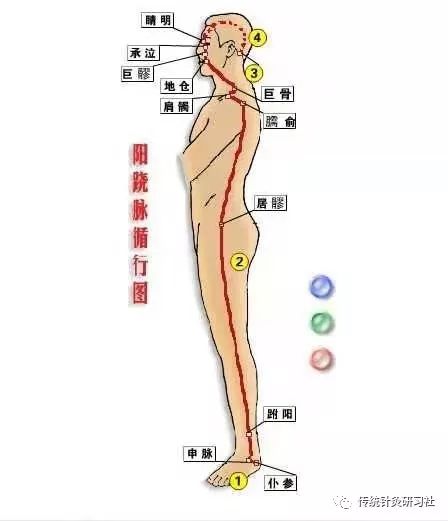
The pathway and physiological functions of the Yang Qiao Mai:
1. Pathway: The Yang Qiao Mai originates from the outer side of the heel at the Shenmai acupoint of the Foot Taiyang Meridian, ascends along the posterior side of the outer ankle, travels up the outer side of the lower limb to the abdomen, along the posterior outer side of the chest, through the shoulder, neck, and up to the corner of the mouth, reaching the inner canthus of the eyes. It connects with the Foot Taiyang and Yin Qiao Mai, then ascends along the Foot Taiyang to meet the Foot Shaoyang at Fengchi (Wind Pool) behind the neck.
2. Physiological functions: It controls the opening and closing of the eyes and muscle movement.
7. Yin Wei Mai Pathway Diagram

The pathway and physiological functions of the Yin Wei Mai:
1. Pathway: The Yin Wei Mai originates from the five cun above the inner ankle at the Zhuxin acupoint of the Foot Shaoyin Meridian, ascends along the inner side of the lower limb, reaches the abdomen, and travels with the Foot Taiyin Spleen Meridian to the lateral costal region, connecting with the Foot Jueyin Liver Meridian, then ascends to meet the Ren Mai at Tiantu, terminating at the Lianquan acupoint in the throat.
2. Physiological functions: The term “Wei” in Wei Mai means to connect and bind. The Yin Wei has the function of connecting the Yin meridians.
8. Yang Wei Mai Pathway Diagram

The pathway and physiological functions of the Yang Wei Mai:
1. Pathway: The Yang Wei Mai originates from the Jimen acupoint of the Foot Taiyang, passes over the outer ankle, ascends along the outer side of the lower limb, travels through the posterior outer side of the trunk, from the back of the armpit to the shoulder, neck, and forward to the forehead, distributing to the side of the head and the back of the neck, connecting with the Du Mai.
2. Physiological functions: It connects the Yang meridians.


